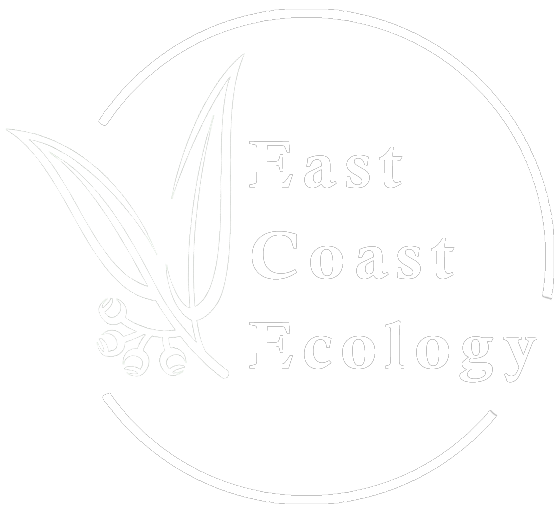
CENTRAL COAST
ENVIRONMENTAL CONSULTANTS
East Coast Ecology is an environmental consultancy that services NSW’s south-eastern coast, including/particularly the Central Coast Local Government Area (LGA).
The Central Coast is an ecologically significant region, with major estuarine systems, abundant vegetation cover and a coastal location. Consequently, Central Coast Council has imposed substantial environmental protection measures for developments pursuant to the Biodiversity Conservation Act 2016 (NSW).
Talk to one of our ecologists today
Give us a call, send us an email or fill out the contact form and one of our experts will get back to you shortly.
PHONE: 02 7813 6119
EMAIL: admin@ececology.com.au
ECOLOGICAL ASSESSMENT PROCESS
Various factors play into the type of environmental/ecological/biodiversity assessment that your Development Application requires.
Development Applications involving the indirect or direct modification of native vegetation (including single tree removal, under scrubbing and vegetation clearing) will require one of two reports:
Biodiversity Development Assessment Report (BDAR) - This report is required when the development proposal triggers the Biodiversity Offset Scheme (BOS). This occurs in one of three ways:
The development is identified on the Biodiversity Values Map; or
The development proposes the clearing or management of native vegetation exceeding the area clearing threshold set out by the Biodiversity Conservation Regulation 2017 (NSW); or
If a 5-part test of significance concludes that the proposed development is likely to ‘significantly affect’ a threatened species or ecological community.
Flora and Fauna Assessment (FFA) - This report is prepared where the proposed development does not trigger the Biodiversity Offset Scheme. This report will include any required 5-part Test (Assessment of Significance).
Reference: Central Coast Council (2019) Flora and Fauna Guidelines
The FFA will also include any necessary assessments for threatened species or ecological communities specified in the Environmental Protection and Biodiversity Conservation Act 1999 (Cth).
LEARN MORE ABOUT TRIGGERING THE BIODIVERSITY OFFSET SCHEME BY CLICKING HERE
A Biodiversity Development Assessment Report (BDAR) can only be prepared by Department of Planning, Industry and Environment-accredited assessors. East Coast Ecology can prepare the necessary BDAR or FFA to accompany the Development Application.
CENTRAL COAST FLORA AND FAUNA GUIDELINES 2019
Central Coast Council’s Flora and Fauna Guidelines provide advice on biodiversity assessment methods used in development applications.
OVERARCHING LEGISLATION
Commonwealth - The Environmental Protection and Biodiversity Conservation Act 1999 (Cth) (EPBC Act) specifies actions that require approval from the Minister if the action has (or is likely to have) a significant impact on a Matter of National Environmental Significance, including:
Nationally listed threatened species;
Nationally listed threatened ecological communities; and
Migratory species.
New South Wales - The Biodiversity Conservation Act 2016 (NSW) (BC Act) and the Environmental Planning and Assessment Act 1979 (NSW) (EP&A Act).
The BC Act outlines a scientific method for assessing development impacts on biodiversity and provides a framework for the avoidance, minimisation and offsetting of these impacts. The BC Act is the principal legislation for environmental/ecological / biodiversity assessments.
The EP&A Act provides a legislative framework for Local Environmental Plans (LEPs), Development Control Plans (DCPs) and State Environmental Planning Policies (SEPPs). This includes the system of lodging, processing and approving Development Applications.
Central Coast – The Central Coast Local Environmental Plan and Development Control Plan must be consulted. These documents govern the protection of locally-significant native vegetation communities, rare species of flora and fauna, and other sensitive environmental features including vegetation constraint areas, ecological buffer areas, riparian lands and watercourses, steep slopes, environmentally sensitive land, and development-excluded land. The applicable LEP or DCP may require an environmental/ecological / biodiversity assessment to accompany a proposed Development Application.
Fisheries Management Act 1994 (NSW) - This statute contains measures to conserve, develop and share fishery resources for the benefit of present and future generations. Actions within a Development Application that could harm important fish habitat will require the approval of the NSW Department of Primary Industries.
Rural Fires Act 1997 (NSW) - This Act provides for the prevention, mitigation, and suppression of bushfire hazards. Where a property is located within Bushfire Prone Land, a development may require an Asset Protection Zone (APZ). Since the APZ may impact native vegetation, an environmental/ecological/biodiversity assessment may be required.
State Environmental Planning Policy (Resilience and Hazards) 2021 (NSW) - This SEPP aims to protect significant wetlands, coastal areas and littoral rainforests from development impacts. Potential development impacts may trigger an environmental or biodiversity assessment.
State Environmental Planning Policy (Koala Habitat Protection) 2021 (NSW) - This SEPP promotes the conservation and management of natural vegetation areas that provide koala habitat and rehabilitate koala population declines. This policy applies to Local Government Areas listed in SEPP Schedule 1, including the Central Coast LGA.These provisions apply to potential development applications and may require a report prepared by a suitably qualified environmental consultant.
OTHER ENVIRONMENTAL ASSESSMENTS AND REPORTS
Dam Dewatering - Native aquatic fauna are protected under the Biodiversity Conservation Act 2016 (NSW). Where a proposed development requires the dewatering, filling or removal of a dam, an ecologist must safely capture and relocate native fauna during works. Council may also require a Dam Dewatering Plan, usually submitted with the development application.
Wildlife Management Plan (WMP) - This plan is required when hollow-bearing trees and/or other important wildlife habitat features are proposed for removal. The plan, prepared by a suitably qualified environmental consultant:
Identifies fauna likely to inhabit the site, and specifies management actions to mitigate risks to native fauna;
Demarcates habitat trees on site and maps these trees;
Demarcates other habitat features for retention/salvage and specifies where salvaged materials are to be placed;
Provides schedules and protocols for vegetation clearing works, including separate protocols for non-habitat vegetation and habitat trees;
Identifies nearby release areas for rescued fauna as well as nearby veterinary practices;
Details a nest box replacement or hollow relocation strategy; and
Details a monitoring program for installed nest boxes and/or salvaged and relocated hollows.
Vegetation Management Plan (VMP) - This plan guides the retention, rehabilitation or protection of native vegetation and may be required by Central Coast Council for proposed developments that indirectly or directly impact native vegetation. A VMP is also required when the proposed development affects riparian land, or is located on a watercourse, under the Water Management Act 2000 (NSW). This plan must be prepared by a suitably qualified environmental consultant.
NOT QUITE AT THE DA STAGE BUT WANT TO KNOW MORE ABOUT THE FEASIBILITY OF YOUR PROPERTY ON THE CENTRAL COAST FOR A DEVELOPMENT?
If you are thinking of purchasing a property on the Central Coast or submitting a Development Application in the Central Coast LGA, we highly recommend an Ecological or Environmental Constraints Report, also known as a pre-construction constraints assessment. This low-cost report can save you time and money by ensuring the development satisfies environmental constraints. This report identifies any threatened ecological communities, threatened flora, and threatened fauna species that are present on the property, in addition to triggers into the Biodiversity Offset Scheme.
East Coast Ecology’s Ecological Constraints Assessment addresses all of the relevant Central Coast environmental constraints you may encounter during the DA stage. This report maximises your development potential whilst streamlining the DA approval process with Central Coast Council.
Contact us
for a free quote
We would love to hear from you.
Give us a call, send us an email or fill out the contact form and one of our experts will get back to you shortly.
PHONE: 02 7813 6119
EMAIL: admin@ececology.com.au




